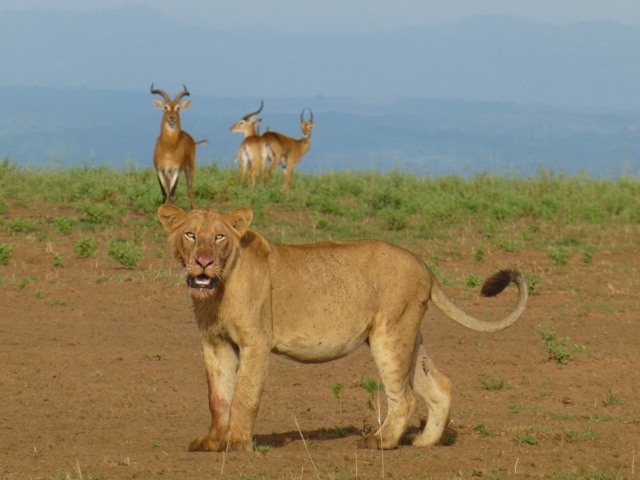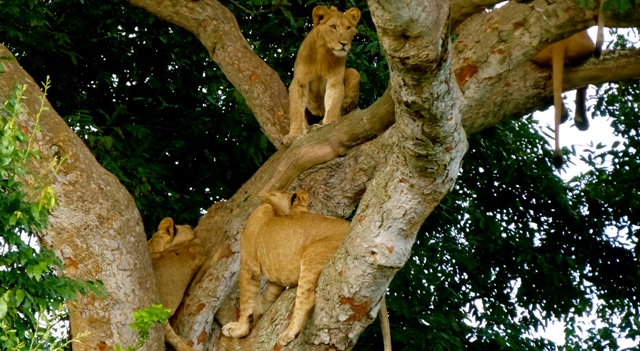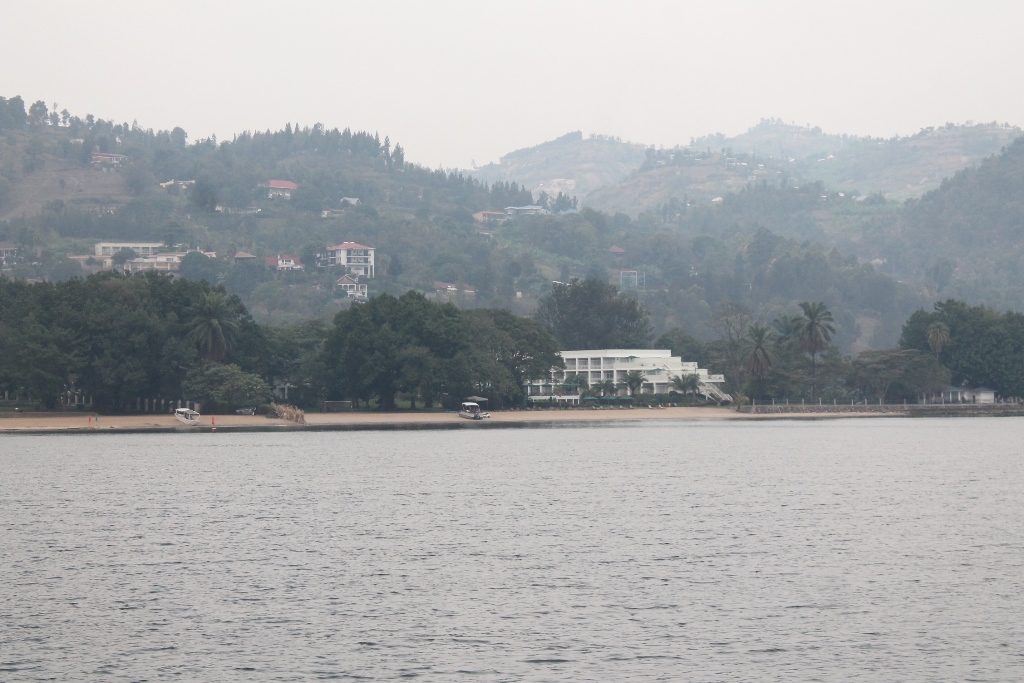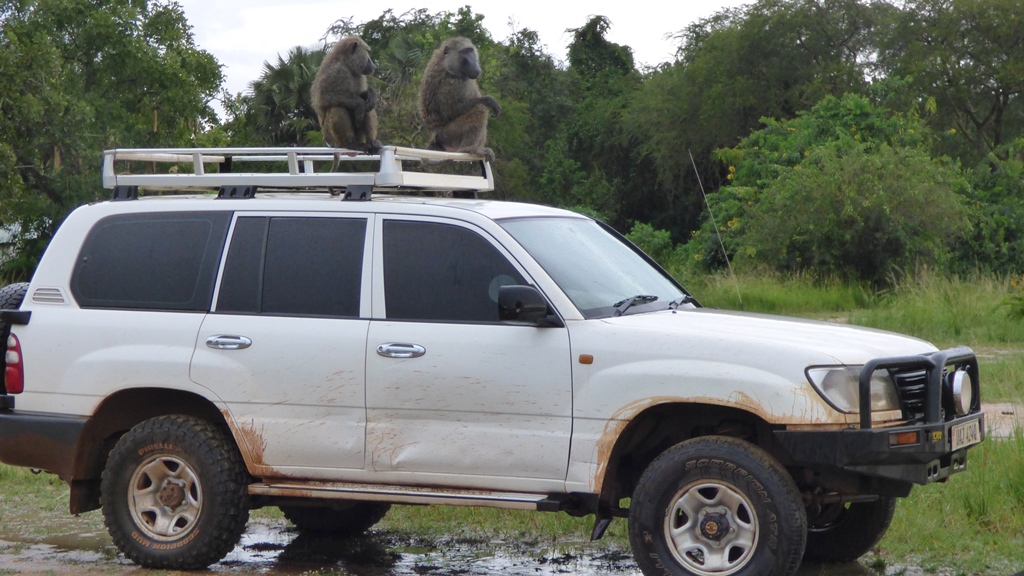
Lions are the iconic attraction of the African safari. Without sighting the Lion, for many the safari would not be a success however plenty of other animals one might have seen. In fact, on setting out into the savannah, the first priority for many is to find the lions before looking for anything else. And catching the lion in action taking down a prey would be the ultimate safari experience… It is like experiencing a Nat Geo moment
Uganda is one of the countries in the world that still have lions roaming the jungle. The lions in Uganda are found in protected wildlife reserves. However, their numbers have for long been dwindling due a number of factors, but the biggest is the human-wildlife as people have continued conflict to invade and encroach on the lion habitat and in the end kill the lions who prey on their cattle.
Seeing lions on a safari in Uganda has been a thing of luck. This trend however is changing as some areas have recently registered an explosion in lion population and resulting in improved sightings of lions. This is thanks to improved conservation efforts by the Uganda Wildlife Authority that’s mandated to protect the game parks and wildlife reserves.
How many lions are in Uganda?
The last research and census carried out between 2018 – 2020 puts the number of lions in Uganda at 373 lions.
You will see lions on game drives when you take a safari trip to the following places in Uganda
Murchison falls national park
Murchison Falls National Park, which is Uganda’s biggest game park, has a population of about 250 lions, the highest number of all the parks.
Murchison Falls national park currently offers the best chances to see lions on safari in Uganda. Chances were not as high previously, it was 50/50 to see lions in Murchison, but of recent it has been observed the park is experiencing an explosion in lion population. Many prides with lots of cubs and juveniles are being seen regularly on game drives (from 215 lions in 2013 to 250 in 2020, this is only lion population increment among all parks). Also, Murchison falls national park being very large and yet with few drive tracks, meant that a large area of the park would not be explored to improve on the chances of seeing the lions. However a few more drive tracks have been opened up in the park, and with increase in number of lions, the park now guarantees lion sightings..
You will search for the lions on the northern bank of the River Nile which divides the park into the north and south parts. The northern part has the savannah which hosts the lions and many other big game
Murchison Falls National Park is also a shorter drive from Kampala as compared to the other parks where lion sightings are also high.
Queen Elizabeth National Park
The last research and census between 2018 – 2020 put the lion population in Queen Elizabeth National Park – Uganda’s second largest park, at just 52 lions.
Queen Elizabeth National Park had built a reputation as the lion park in Uganda, where you didn’t have to do a lot of searching to see lions. One problem however is that Queen Elizabeth National Park, unlike Murchison Falls park, is a biosphere, meaning wildlife and man have been coexisting peacefully in the same eco system since time memorial. It is not unusual to find a pride of lions or a herd of elephants and after a few meters later you will encounter a local man walking or going about his business without any worry about his surroundings. However, it was not so long that the rapidly growing population and its growing economic needs would lead to conflict with the wildlife, and the first wildlife victims are the predators. The locals started rearing cattle within & near the park (which is actually prohibited) which the lions started feasting on and the locals retaliated by killing them en masse. To put it in perspective, the lion population in Queen Elizabeth National Park in 2010 was 144, ten years down the road and they have been reduced to less than half.
The Uganda Wildlife Authority has embarked on fencing some parts of the park which will help deter animals from going into communities and vice versa. This is expected to provide reduce the human-wildlife conflict and sooner we shall have a restored park with lots of lions.
All is not lost however as Queen Elizabeth National Park still provides high chances of seeing the lions. The Kasenyi plains, the breeding ground for antelopes is the hunting ground for lions and other predators.
The Mweya peninsula near to Mweya Safari Loge was a breeding ground of a lion pride and is one of the places you may find lions in Queen Elizabeth National Park.
Lion tracking in Queen Elizabeth National Park
To guarantee seeing lions, Queen Elizabeth National Park provides a lion tracking activity where you can join a group of researchers to locate collared lions that are under surveillance. This activity provides a better closeup experience of the lions in case you want to learn more about lions.
The tree-climbing lions of Ishasha

South of the park in the Ishasha plains are special lions, the tree-climbing lions. The tree-climbing lions have become the iconic attraction of the park. The lions in this area of the park tend to climb fig trees after morning mostly to relax after the morning hunt and also escape from the flies and bugs on ground.
Many people who go through Queen Elizabeth national park want to catch this spectacle of an entire pride of lions “chilling” high up in tree branches like monkeys. Needs a bit of luck though.
Queen Elizabeth is more than just lions
Important to note is that Queen Elizabeth national park is not just about lions and animals, but its scenery too is one of the reasons to visit. Located on the edge of the rift valley its landscape is of lush plains, green hills and a series of crater lakes and lakes Edward and George that attract lots of wildlife.
Kidepo valley national park
The lion population in Kidepo Valley National Park is estimated to be 70 individuals as per the census and research done between 2018 – 2020.
Kidepo National Park is normally identified in pictures by one or two lions sitting on a rocky outcrop overseeing the magnificent wilderness of Kidepo. It is like a scene in The Lion King movie!
Kidepo Valley national park is indeed a good place to see lions in Uganda. However, because of the vastness of the park sometimes the sightings are too distant or the lions are not in sight.
Lake Mburo national park
Lake Mburo National Park should not be featuring on this list but then it does have a lion, just one recorded male lion inhabits the park. It is rarely seen, its more like a myth, but then once in a while it will be heard roaring.
Do not plan your trip to Lake Mburo to see lions. There are predators in a good numbers like leopards and hyenas.
What is the best season to see lions in Uganda?
Lions will be seen throughout the year no matter the season. However, the dry season (June – August, Dec – Feb) will provide better conditions to explore the drive tracks and get to more areas of the park. Also, the savannah is shorter or less thick making it easier to spot the lions among the bushes.
What is the best time to see lions?
The best time of day to see the lions is definitely early morning when the lions are actively hunting or are just from the hunt and are still actively moving in the open. As the day gets hotter, they will look for a nice shade, mostly under a thicket where they will be difficult to see, and sleep away the day. The next good time to see the lions in the evening when they are up and want to hunt again. It is also cooler during this time so they will be moving in the open.
How to plan a lion safari in Uganda?
If you feel you don’t want to miss the lions on your safari in Uganda, the best idea is to visit at least two of the parks with lions. That would be, Murchison Falls National Park plus any of the other two. Murchison Falls National Park and Queen Elizabeth would be easier to combine because of the shorter distances. However if you can endure the long drive to Kidepo or take a flight, it would be worthwhile.
Leave a comment Cancel reply
Archives
- March 2025 (1)
- February 2025 (1)
- January 2025 (1)
- November 2024 (2)
- October 2024 (3)
- May 2024 (1)
- February 2024 (1)
- January 2024 (2)
- November 2023 (2)
- September 2023 (1)
- July 2023 (8)
- June 2023 (14)
- May 2023 (1)
- April 2023 (1)
- March 2023 (3)
- February 2023 (6)
- January 2023 (6)
- December 2022 (1)
- November 2022 (1)
- October 2022 (2)
- September 2022 (1)
- August 2022 (1)
- May 2022 (17)
- April 2022 (5)
- March 2022 (7)
- February 2022 (3)
- January 2022 (7)
- December 2021 (7)
- November 2021 (2)
- October 2021 (1)
- September 2021 (2)
- August 2021 (2)
- July 2021 (6)
- June 2021 (1)
- May 2021 (4)
- April 2021 (3)
- March 2021 (2)
- February 2021 (2)
- January 2021 (14)
- November 2020 (2)
- September 2020 (1)
- March 2020 (1)
- February 2020 (1)
- August 2019 (1)
- September 2016 (1)
- June 2016 (1)
- May 2016 (1)

